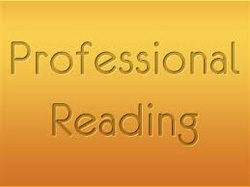 Not only does summer provide time for teachers to catch up on sleep and devour books that they might like to use in their classrooms, but those more leisurely days and nights often give them a chance to seek out books about topics that seem interesting or provocative. Sometimes staying abreast of pedagogical trends and literacy research can be challenging during the regular school year because of the many responsibilities placed upon teachers. Now that the previous year’s grading, meetings, and classroom management concerns lie far behind us and the first days of school in August seem so far away, this is the ideal time to explore some of those professional books colleagues have been discussing or find new approaches to teaching practices. Written by members of the Children's Literature and Reading Special Interest Group, these book reviews on professional texts may encourage changes in thinking about education and they might even prompt some readers to write their own professional books. In addition to the books featured in this column, teachers might want to check out three highly recommended titles reviewed in earlier columns:
Not only does summer provide time for teachers to catch up on sleep and devour books that they might like to use in their classrooms, but those more leisurely days and nights often give them a chance to seek out books about topics that seem interesting or provocative. Sometimes staying abreast of pedagogical trends and literacy research can be challenging during the regular school year because of the many responsibilities placed upon teachers. Now that the previous year’s grading, meetings, and classroom management concerns lie far behind us and the first days of school in August seem so far away, this is the ideal time to explore some of those professional books colleagues have been discussing or find new approaches to teaching practices. Written by members of the Children's Literature and Reading Special Interest Group, these book reviews on professional texts may encourage changes in thinking about education and they might even prompt some readers to write their own professional books. In addition to the books featured in this column, teachers might want to check out three highly recommended titles reviewed in earlier columns:
- Bullying Hurts: Teaching Kindness through Read-alouds and Guided Conversations by Lester L. Laminack and Reba Wadsworth (Heinemann, 2012)
- Both The Poetry Friday Anthology for Common Core Grades K-5: Poems for the School Year with Connections to the Common Core (Pomelo, 2012)
- The Poetry Friday Anthology for Middle School, Grades 6-8: Poems for the School Year with Connections to the Common Core State Standards (CCSS) for English Language Arts by Sylvia Vardell and Janet Wong (Pomelo, 2013)
Whether read alone or with a teacher study group, these titles offer much academic food for thought. Teachers may be interested in reading about the Professional Development opportunities at ReadWriteThink.
Calkins, Lucy, Ehrenworth, Mary, and Lehman, Christopher. (2012). Pathways to the common core: Accelerating achievement. Portsmouth, NH: Heinemann.
 Noted literacy educator Lucy Calkins and her colleagues from the Reading and Writing Project at Teachers College, Columbia, University, provide an accessible introduction and pathway to understanding the new Common Core State Standards. In their introduction they state, “This book … is written for educators who are eager to embrace the responsibilities of implementing the Common Core, who see schools as centers of professional study, and who believe that teaching well means engaging in a continual process of studying students and their work in order to strengthen teaching and learning.” The introduction cleverly goes on to question the approach and attitude that educators use when starting on this pathway – as curmudgeons or finding the gold standard? The book is divided into three main sections: Reading Standards; Writing Standards; and Speaking/Listening and Language Standards. The content of the book begins with an overview of the standards and a “nuts and bolts” look at what the standards do and don’t do for reading comprehension implementation for literature and nonfiction. From there, each standard is discussed one by one with chapter headings that include: Literal Understanding and Text Complexity; Reading Literature; Reading Information Text. Moving on to the writing standards, chapter headings continue with: An Overview; Composing Narrative Texts; Composing Argument Texts; Composing Information Texts. Concluding with the speaking/listening standards chapter headings are the Overview and the CCSS-Aligned Assessments Fuel Whole-School Reform. The detailed index makes this a useful and handy tool for implementation by teachers, literacy coaches, administrators or professional learning communities. Teachers can watch students interacting with these techniques in several videos found at The Reading & Writing Project website or listen to Lucy Calkins talk about this book at the vimeo website.
Noted literacy educator Lucy Calkins and her colleagues from the Reading and Writing Project at Teachers College, Columbia, University, provide an accessible introduction and pathway to understanding the new Common Core State Standards. In their introduction they state, “This book … is written for educators who are eager to embrace the responsibilities of implementing the Common Core, who see schools as centers of professional study, and who believe that teaching well means engaging in a continual process of studying students and their work in order to strengthen teaching and learning.” The introduction cleverly goes on to question the approach and attitude that educators use when starting on this pathway – as curmudgeons or finding the gold standard? The book is divided into three main sections: Reading Standards; Writing Standards; and Speaking/Listening and Language Standards. The content of the book begins with an overview of the standards and a “nuts and bolts” look at what the standards do and don’t do for reading comprehension implementation for literature and nonfiction. From there, each standard is discussed one by one with chapter headings that include: Literal Understanding and Text Complexity; Reading Literature; Reading Information Text. Moving on to the writing standards, chapter headings continue with: An Overview; Composing Narrative Texts; Composing Argument Texts; Composing Information Texts. Concluding with the speaking/listening standards chapter headings are the Overview and the CCSS-Aligned Assessments Fuel Whole-School Reform. The detailed index makes this a useful and handy tool for implementation by teachers, literacy coaches, administrators or professional learning communities. Teachers can watch students interacting with these techniques in several videos found at The Reading & Writing Project website or listen to Lucy Calkins talk about this book at the vimeo website.
- Karen Hildebrand, Ohio Library and Reading Consultant
Kelley, Michelle & Clausen-Grace, Nicki. (2012). Reading the whole page: Teaching and assessing text features to meet K-5 common core standards. Gainesville, FL: Maupin House.
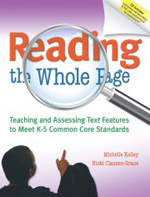 As stated in the title, this book is geared for elementary students and concepts that teach them to use text features not only in their reading but also guiding them to use text features within their own writing. Logically, chapter one opens the book with the importance of text features, how they help students, stressing the importance of teaching specific features and continuing with assessment ideas. Chapters 2, 3, and 4 offer a plethora of mini-lessons that include specific features on the use of titles, headings and subheadings, bold print italics, captions, pronunciation guides, bullets, sidebars, photographs and drawings, insets, cross-sections/cutaways, diagrams, maps, timelines, graphs, tables, tables of contents, index and glossary features. Chapter 5, the final chapter, offers ways to integrate all these text features with activities like a scavenger hunt, using them in morning messages, flap books and interviews to name just a few. The appendices (A through F) that make up just less than half the book, offer reproducible activities, a chart of the Common Core Standards relevant for student reading, charts, sort cards and more. This book is definitely a “hands-on/use tomorrow” kind of guidebook for teachers who want to get started with new ideas that are standards-based for elementary students. The book includes a CD with interactive reproducible ideas. Educators can take a look at Appendix F available on the CD in this downloadable list of resources available from the publisher’s website.
As stated in the title, this book is geared for elementary students and concepts that teach them to use text features not only in their reading but also guiding them to use text features within their own writing. Logically, chapter one opens the book with the importance of text features, how they help students, stressing the importance of teaching specific features and continuing with assessment ideas. Chapters 2, 3, and 4 offer a plethora of mini-lessons that include specific features on the use of titles, headings and subheadings, bold print italics, captions, pronunciation guides, bullets, sidebars, photographs and drawings, insets, cross-sections/cutaways, diagrams, maps, timelines, graphs, tables, tables of contents, index and glossary features. Chapter 5, the final chapter, offers ways to integrate all these text features with activities like a scavenger hunt, using them in morning messages, flap books and interviews to name just a few. The appendices (A through F) that make up just less than half the book, offer reproducible activities, a chart of the Common Core Standards relevant for student reading, charts, sort cards and more. This book is definitely a “hands-on/use tomorrow” kind of guidebook for teachers who want to get started with new ideas that are standards-based for elementary students. The book includes a CD with interactive reproducible ideas. Educators can take a look at Appendix F available on the CD in this downloadable list of resources available from the publisher’s website.
These two authors collaborated on a project and study guide for IRA entitled, “Comprehension Shouldn’t Be Silent; from strategy instruction to student independence.” The study guide is available as a download from /.
- Karen Hildebrand, Ohio Library and Reading Consultant
McGregor, Tanny. (2013). Genre connections: lessons to launch literary and nonfiction texts. Portsmouth, NH: Heinemann.
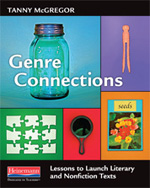 Author Tanny McGregor (Comprehension Connections, 2007; Comprehension Going Forward, 2011) has returned with a very user-friendly book for classroom teachers to invite the study of genres in today’s classroom emphasizing using concrete and abstract objects. In the opening chapter, McGregor describes the why and how of explaining genre including “launching the sequence” (p.3) to create experiences to understand and learn about genre. This same chapter explains the Concrete Experience to make genre real and moves on to the Sensory Experience featuring art and music. Chapters 2 through 8 deal with the specific genres of Poetry; Adventure and Fantasy: Beyond Realistic Fiction; Historical Fiction; Drama; Image Reading; Biography, Autobiography and Memoir; Informational Text. Within each chapter she has laid out the pattern for each genre instruction with the steps: Launching Sequence; Noticing and Naming the Genre on Their Own; Sensory Exercises; Quotations About …; and Time for Text. From McGregor’s opening, “There are dozens of genres on the continuum between narrative (story) and expository (informational); this book will explore but a few. Any genre could be launched using the model in this book, for example, realistic fiction, mystery, or technical writing. Teachers can use the seed ideas suggested in this volume with a genre of your choice and see how it grows!” (p.2). Teachers may want to listen to the author discuss her book in an interview on EduTalkRadio.
Author Tanny McGregor (Comprehension Connections, 2007; Comprehension Going Forward, 2011) has returned with a very user-friendly book for classroom teachers to invite the study of genres in today’s classroom emphasizing using concrete and abstract objects. In the opening chapter, McGregor describes the why and how of explaining genre including “launching the sequence” (p.3) to create experiences to understand and learn about genre. This same chapter explains the Concrete Experience to make genre real and moves on to the Sensory Experience featuring art and music. Chapters 2 through 8 deal with the specific genres of Poetry; Adventure and Fantasy: Beyond Realistic Fiction; Historical Fiction; Drama; Image Reading; Biography, Autobiography and Memoir; Informational Text. Within each chapter she has laid out the pattern for each genre instruction with the steps: Launching Sequence; Noticing and Naming the Genre on Their Own; Sensory Exercises; Quotations About …; and Time for Text. From McGregor’s opening, “There are dozens of genres on the continuum between narrative (story) and expository (informational); this book will explore but a few. Any genre could be launched using the model in this book, for example, realistic fiction, mystery, or technical writing. Teachers can use the seed ideas suggested in this volume with a genre of your choice and see how it grows!” (p.2). Teachers may want to listen to the author discuss her book in an interview on EduTalkRadio.
- Karen Hildebrand, Ohio Library and Reading Consultant
McLaughlin, Maureen, & Overturf, Brenda J. (2013). The Common Core: Teaching K-5 students to meet the Reading Standards. Newark, DE: International Reading Association.
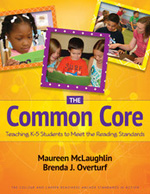 Not a minute too soon, teachers can learn about the background behind the sudden appearance of the Common Core State Standards that seem to have threaded their way into state and national requirements and daily lesson plans. In the book’s two sections, the authors explain the CCSS’s key points and then suggest effective ways to use the standards in instruction. Examining the standards vertically within each grade level as well as horizontally across grade levels will help teachers understand grade level expectations. The authors even devote a chapter to assessment, discussing how formative and summative assessment connect to the CCSS, and providing examples of simple types of formative assessment such as discussions or Tickets Out that teachers can use. Using five guiding questions, they examine each College and Career Readiness Anchor Standard for Reading and its related CCSS for grades K-5 Standards. They provide examples of teaching practices and activities that teachers can incorporate as well as discussing links to technology. Although the authors admit that designing student-centered lessons that are based on the CCSS is challenging, this book provides plenty of support and encouragement for teachers to do so. The book is thorough and best understood by reading a chapter or two at a time and then digesting its contents or discussing them with a colleague.
Not a minute too soon, teachers can learn about the background behind the sudden appearance of the Common Core State Standards that seem to have threaded their way into state and national requirements and daily lesson plans. In the book’s two sections, the authors explain the CCSS’s key points and then suggest effective ways to use the standards in instruction. Examining the standards vertically within each grade level as well as horizontally across grade levels will help teachers understand grade level expectations. The authors even devote a chapter to assessment, discussing how formative and summative assessment connect to the CCSS, and providing examples of simple types of formative assessment such as discussions or Tickets Out that teachers can use. Using five guiding questions, they examine each College and Career Readiness Anchor Standard for Reading and its related CCSS for grades K-5 Standards. They provide examples of teaching practices and activities that teachers can incorporate as well as discussing links to technology. Although the authors admit that designing student-centered lessons that are based on the CCSS is challenging, this book provides plenty of support and encouragement for teachers to do so. The book is thorough and best understood by reading a chapter or two at a time and then digesting its contents or discussing them with a colleague.
- Barbara A. Ward, Washington State University, Pullman
McLaughlin, Maureen, & and Overturf, Brenda J. (2013). The Common Core: Teaching students in Grades 6–12 to meet the Reading Standards. Newark, DE: International Reading Association.
 As they do so effectively in their earlier title focused on earlier grades, the authors painstakingly explain the CCSS’s key points of the CCSS and provide tips on how to use the Standards effectively in literacy instruction in grades 6-12. The book is divided into two sections with the first part containing six chapters, and the second one containing ten. Chapters in the first section include “How Can Teachers Effectively Use the Standards?” “Assessment and the Common Core,” “Implementation of the Common Core Standards,” “Beginning Readers, the Teaching of Reading, and the Common Core,” “English Learners, Students With Disabilities, Gifted and Talented Learners, and the Common Core,” and “Reshaping Curriculum to Accommodate the Common Core and the Teaching of Reading.” While exploring assessment, implementation, and curriculum, the authors also look at some of the implications of the Common Core for English language learners, students with disabilities, and gifted and talented students. One entire chapter offers suggestions for teaching students how to use disciplinary strategies to engage, guide, and extend their thinking. The second section of the book examines carefully each of the College and Career Readiness Anchor Standards for Reading, along with practical guidance on how to use those Standards to teach your middle school and high school students. Teachers will find the classroom applications and student examples particularly helpful in familiarizing them with the CCSS.
As they do so effectively in their earlier title focused on earlier grades, the authors painstakingly explain the CCSS’s key points of the CCSS and provide tips on how to use the Standards effectively in literacy instruction in grades 6-12. The book is divided into two sections with the first part containing six chapters, and the second one containing ten. Chapters in the first section include “How Can Teachers Effectively Use the Standards?” “Assessment and the Common Core,” “Implementation of the Common Core Standards,” “Beginning Readers, the Teaching of Reading, and the Common Core,” “English Learners, Students With Disabilities, Gifted and Talented Learners, and the Common Core,” and “Reshaping Curriculum to Accommodate the Common Core and the Teaching of Reading.” While exploring assessment, implementation, and curriculum, the authors also look at some of the implications of the Common Core for English language learners, students with disabilities, and gifted and talented students. One entire chapter offers suggestions for teaching students how to use disciplinary strategies to engage, guide, and extend their thinking. The second section of the book examines carefully each of the College and Career Readiness Anchor Standards for Reading, along with practical guidance on how to use those Standards to teach your middle school and high school students. Teachers will find the classroom applications and student examples particularly helpful in familiarizing them with the CCSS.
- Barbara A. Ward, Washington State University Pullman
Kucan, Linda, & Palincsar, Annemarie Sullivan. (2013). Comprehension instruction through text-based discussion. Newark, DE: International Reading Association.
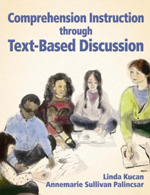 With a free PDF and an accompanying DVD that provide a guide for professional development meetings or teacher educators and suggested informational texts for classroom discussions, this excellent teacher resource provides tools for discussion that is text-based, allowing teachers to adhere to the Common Core State Standards for English Language Arts that encourage elementary teachers to use more informational texts and promote engagement with text that “builds knowledge, enlarges experience, and broadens worldviews.” The authors provide several suggests for how to build on what students already know by supporting their understanding of the ideas they encounter as they read. After discussing the theoretical support for quality discussions based on texts that are intended to enhance comprehension, the authors explain thoroughly lessons that will help teachers know how to analyze text, plan and initiate discussions, and support students as they work with texts. There are six chapters, four of which focus on planning and discussing “Harnessing the Wind,” “Black Death,” “Coral Reefs,” and “Jade Burial Suits.” These chapters are terrific models of how teachers can stretch their students and enliven their own instructional practices with simple changes.
With a free PDF and an accompanying DVD that provide a guide for professional development meetings or teacher educators and suggested informational texts for classroom discussions, this excellent teacher resource provides tools for discussion that is text-based, allowing teachers to adhere to the Common Core State Standards for English Language Arts that encourage elementary teachers to use more informational texts and promote engagement with text that “builds knowledge, enlarges experience, and broadens worldviews.” The authors provide several suggests for how to build on what students already know by supporting their understanding of the ideas they encounter as they read. After discussing the theoretical support for quality discussions based on texts that are intended to enhance comprehension, the authors explain thoroughly lessons that will help teachers know how to analyze text, plan and initiate discussions, and support students as they work with texts. There are six chapters, four of which focus on planning and discussing “Harnessing the Wind,” “Black Death,” “Coral Reefs,” and “Jade Burial Suits.” These chapters are terrific models of how teachers can stretch their students and enliven their own instructional practices with simple changes.
- Barbara A. Ward, Washington State University Pullman
Martinelli, Marjorie, & Mraz, Kristine. (2012). Smarter charts: K-2: Optimizing an instructional staple to create independent readers and writers. Portsmouth, NH: Heinemann.
 Although commercially-produced charts have a place in the classroom, many teachers want to make sure that the charts they use are meaningful for their own students and will enhance learning. The authors have written a helpful book that shows teachers how to create their own charts while also providing examples of charts they have created. After discussing the importance of visual literacy and the appeal of advertising, the authors provide a field guide to literacy charts, including routine, strategy, process, exemplar, and genre charts. For instance, a process chart is intended to break an important skill into a series of steps (p. xxi). The authors even show teachers how to draw a pencil on a chart and include transcripts of how teachers use their charts with their students. While the charts can be excellent instructional tools, they also can provide ways to assess student progress. Ultimately, as the authors write in the conclusion, “Charts help to make our teaching explicit and clear by providing step-by-step directions and key tips and strategies for how to do something” (p. 86). Since students can use the charts to self-assess and set their own goals, the experience becomes empowering and leads to independence. After reading this book, teachers will never look at classroom charts in the same way. They’re far more part of creating a visually-appealing classroom.
Although commercially-produced charts have a place in the classroom, many teachers want to make sure that the charts they use are meaningful for their own students and will enhance learning. The authors have written a helpful book that shows teachers how to create their own charts while also providing examples of charts they have created. After discussing the importance of visual literacy and the appeal of advertising, the authors provide a field guide to literacy charts, including routine, strategy, process, exemplar, and genre charts. For instance, a process chart is intended to break an important skill into a series of steps (p. xxi). The authors even show teachers how to draw a pencil on a chart and include transcripts of how teachers use their charts with their students. While the charts can be excellent instructional tools, they also can provide ways to assess student progress. Ultimately, as the authors write in the conclusion, “Charts help to make our teaching explicit and clear by providing step-by-step directions and key tips and strategies for how to do something” (p. 86). Since students can use the charts to self-assess and set their own goals, the experience becomes empowering and leads to independence. After reading this book, teachers will never look at classroom charts in the same way. They’re far more part of creating a visually-appealing classroom.
- Barbara A. Ward, Washington State University Pullman
Yopp, Hallie Kay, & Yopp, Ruth Helen. (2013). Literature-Based reading activities: Engaging students with literary and informational text. Sixth Edition. Upper Saddle River, NJ: Pearson.
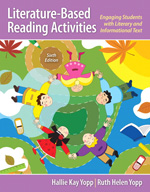 This updated version of an ever-popular resource for teachers provides useful tips on how to use literature in the classroom. The book contains five chapters, one of which gives a rationale for using literature in the classroom. Chapters Two, Three, and Four offer 15 prereading, 15 during-reading, and 13 post-reading activities, and Chapter Five explores writing and bookmaking activities. After explaining what each activity is, the authors have provided examples of each activity so that teachers can easily create their own for use in their classrooms. For instance, as part of the preparation for reading, teachers might choose to design an anticipation guide, an opinionnaire/questionnaire, book box, book bits or pull out character quotes to encourage students to draw on and build their background knowledge about a topic or issue as well as motivate them to read. During-reading activities might include literature circles, strategy cards, character perspective charts, and character blogs, among others, all designed to encourage personal responses and deepen comprehension. Intended to help students make connections and to promote reflection, post-reading activities include sketch to stretch, dramatic responses, book trailers, Venn diagrams, and book charts, among others. The final chapter contains creative activities such as pop-up books, accordion books, mini fold-up books, baggie books, and digital responses to literature. Chockfull of activities that students will enjoy immensely, the book also contains a list of Internet resources and the College and Career Readiness Anchor Standards for the Common Core State Standards. For teachers searching for a way to add excitement to their approach to literacy, this book is a must-have.
This updated version of an ever-popular resource for teachers provides useful tips on how to use literature in the classroom. The book contains five chapters, one of which gives a rationale for using literature in the classroom. Chapters Two, Three, and Four offer 15 prereading, 15 during-reading, and 13 post-reading activities, and Chapter Five explores writing and bookmaking activities. After explaining what each activity is, the authors have provided examples of each activity so that teachers can easily create their own for use in their classrooms. For instance, as part of the preparation for reading, teachers might choose to design an anticipation guide, an opinionnaire/questionnaire, book box, book bits or pull out character quotes to encourage students to draw on and build their background knowledge about a topic or issue as well as motivate them to read. During-reading activities might include literature circles, strategy cards, character perspective charts, and character blogs, among others, all designed to encourage personal responses and deepen comprehension. Intended to help students make connections and to promote reflection, post-reading activities include sketch to stretch, dramatic responses, book trailers, Venn diagrams, and book charts, among others. The final chapter contains creative activities such as pop-up books, accordion books, mini fold-up books, baggie books, and digital responses to literature. Chockfull of activities that students will enjoy immensely, the book also contains a list of Internet resources and the College and Career Readiness Anchor Standards for the Common Core State Standards. For teachers searching for a way to add excitement to their approach to literacy, this book is a must-have.
- Barbara A. Ward, Washington State University Pullman
These reviews are submitted by members of the International Reading Association's Children's Literature and Reading Special Interest Group (CL/R SIG) and are published weekly on Reading Today Online. The International Reading Association partners with the National Council of Teachers of English and Verizon Thinkfinity to produce ReadWriteThink.org, a website devoted to providing literacy instruction and interactive resources for grades K–12.